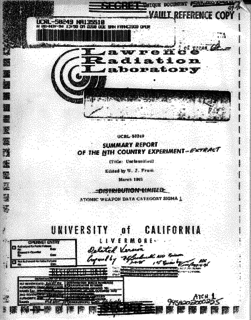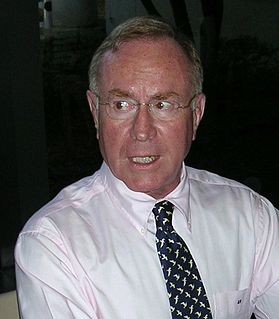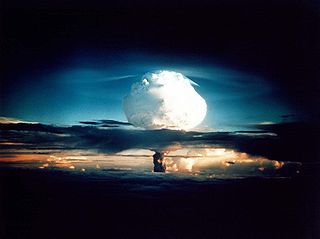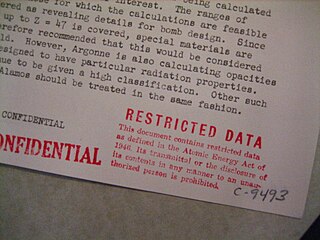Related Research Articles

The Nth Country Experiment was an experiment conducted by Lawrence Livermore National Laboratory starting in May 1964 which sought to assess the risk of nuclear proliferation. The experiment consisted in paying three recent young physicists who had just received their PhDs, though had no prior weapons experience, to develop a working nuclear weapon design using only unclassified information, and with basic computational and technical support. "The goal of the participants should be to design an explosive with a militarily significant yield", the report on the experiment read, "A working context for the experiment might be that the participants have been asked to design a nuclear explosive which, if built in small numbers, would give a small nation a significant effect on their foreign relations."

Classified Information is material that a government body deems to be sensitive information that must be protected. Access is restricted by law or regulation to particular groups of people with the necessary security clearance and need to know, and mishandling of the material can incur criminal penalties.
A security clearance is a status granted to individuals allowing them access to classified information or to restricted areas, after completion of a thorough background check. The term "security clearance" is also sometimes used in private organizations that have a formal process to vet employees for access to sensitive information. A clearance by itself is normally not sufficient to gain access; the organization must also determine that the cleared individual needs to know specific information. No individual is supposed to be granted automatic access to classified information solely because of rank, position, or a security clearance.
Wen Ho Lee or Li Wenho is a Taiwanese-American scientist who worked for the University of California at the Los Alamos National Laboratory in New Mexico. He created simulations of nuclear explosions for the purposes of scientific inquiry, as well as for improving the safety and reliability of the U.S. nuclear arsenal. A federal grand jury indicted him on charges of stealing secrets about the U.S. nuclear arsenal for the People's Republic of China (PRC) in December 1999.

Richard Lee Rhodes is an American historian, journalist, and author of both fiction and non-fiction, including the Pulitzer Prize-winning The Making of the Atomic Bomb (1986), and most recently, Energy: A Human History (2018).

The Vela incident, also known as the South Atlantic Flash, was an unidentified double flash of light detected by an American Vela Hotel satellite on 22 September 1979 near the Prince Edward Islands in the Indian Ocean.

The Atomic Energy Act of 1946 determined how the United States would control and manage the nuclear technology it had jointly developed with its World War II allies, the United Kingdom and Canada. Most significantly, the Act ruled that nuclear weapon development and nuclear power management would be under civilian, rather than military control, and established the United States Atomic Energy Commission for this purpose.

United States of America v. Progressive, Inc., Erwin Knoll, Samuel Day, Jr., and Howard Morland, 467 F. Supp. 990, was a lawsuit brought against The Progressive magazine by the United States Department of Energy (DOE) in 1979. A temporary injunction was granted against The Progressive to prevent the publication of an article written by activist Howard Morland that purported to reveal the "secret" of the hydrogen bomb. Though the information had been compiled from publicly available sources, the DOE claimed that it fell under the "born secret" clause of the Atomic Energy Act of 1954.

A thermonuclear weapon, fusion weapon or hydrogen bomb is a second-generation nuclear weapon design. Its greater sophistication affords it vastly greater destructive power than first-generation atomic bombs, a more compact size, a lower mass, or a combination of these benefits. Characteristics of nuclear fusion reactions make possible the use of non-fissile depleted uranium as the weapon's main fuel, thus allowing more efficient use of scarce fissile material such as uranium-235 or plutonium-239.

The 1958 US–UK Mutual Defense Agreement, or UK–US Mutual Defence Agreement, is a bilateral treaty between the United States and the United Kingdom on nuclear weapons co-operation. The treaty's full name is Agreement between the Government of the United States of America and the Government of the United Kingdom of Great Britain and Northern Ireland for Cooperation on the uses of Atomic Energy for Mutual Defense Purposes. It allows the US and the UK to exchange nuclear materials, technology and information. The US has nuclear co-operation agreements with other countries, including France and other NATO countries, but this agreement is by far the most comprehensive. Because of the agreement's strategic value to Britain, Harold Macmillan called it "the Great Prize".

This article chronicles the history and origins of the Teller–Ulam design, the technical concept behind modern thermonuclear weapons, also known as hydrogen bombs. The design, the details of which are military secrets known to only a handful of major nations, is believed to be used in virtually all modern nuclear weapons that make up the arsenals of the major nuclear powers.
Critical Nuclear Weapon Design Information is a U.S. Department of Defense (DoD) category of Top Secret Restricted Data or Secret Restricted Data that reveals the theory of operation or design of the components of a thermonuclear or fission bomb, warhead, demolition munition, or test device. Specifically excluded is information concerning arming, fuzing, and firing systems; limited life components; and total contained quantities of fissionable, fusionable, and high explosive materials by type. Among these excluded items are the components that DoD personnel set, maintain, operate, test or replace. The sensitivity of DoD CNWDI is such that access is granted to the absolute minimum number of employees who require it for the accomplishment of assigned responsibilities on a classified contract. Because of the importance of such information, special requirements have been established for its control.

Atomic spies or atom spies were people in the United States, the United Kingdom, and Canada who are known to have illicitly given information about nuclear weapons production or design to the Soviet Union during World War II and the early Cold War. Exactly what was given, and whether everyone on the list gave it, are still matters of some scholarly dispute. In some cases, some of the arrested suspects or government witnesses had given strong testimonies or confessions which they recanted later or said were fabricated. Their work constitutes the most publicly well-known and well-documented case of nuclear espionage in the history of nuclear weapons. At the same time, numerous nuclear scientists wanted to share the information with the world scientific community, but this proposal was firmly quashed by the United States government.
The United States government classification system is established under Executive Order 13526, the latest in a long series of executive orders on the topic. Issued by President Barack Obama in 2009, Executive Order 13526 replaced earlier executive orders on the topic and modified the regulations codified to 32 C.F.R. 2001. It lays out the system of classification, declassification, and handling of national security information generated by the U.S. government and its employees and contractors, as well as information received from other governments.
Special access programs (SAPs) in the U.S. Federal Government are security protocols that provide highly classified information with safeguards and access restrictions that exceed those for regular (collateral) classified information. SAPs can range from black projects to routine but especially-sensitive operations, such as COMSEC maintenance or presidential transportation support. In addition to collateral controls, a SAP may impose more stringent investigative or adjudicative requirements, specialized nondisclosure agreements, special terminology or markings, exclusion from standard contract investigations (carve-outs), and centralized billet systems. Within the Department of Defense, SAP is better known as "SAR" by the mandatory Special Access Required (SAR) markings.

Q clearance or Q access authorization is the United States Department of Energy (DOE) security clearance required to access Top Secret Restricted Data, Formerly Restricted Data, and National Security Information, as well as Secret Restricted Data. Restricted Data (RD) is defined in the Atomic Energy Act of 1954 and covers nuclear weapons and related materials. The lower-level L clearance is sufficient for access to Secret Formerly Restricted Data (FRD) and National Security Information, as well as Confidential Restricted Data, Formerly Restricted Data, and National Security Information. Access to Restricted Data is only granted on a need-to-know basis to personnel with appropriate clearances.
An L clearance is a security clearance used by the United States Department of Energy (DOE) and Nuclear Regulatory Commission for civilian access relating to nuclear materials and information under the Atomic Energy Act of 1954. It is equivalent to a United States Department of Defense (DOD) Secret clearance.

Nuclear espionage is the purposeful giving of state secrets regarding nuclear weapons to other states without authorization (espionage). There have been many cases of known nuclear espionage throughout the history of nuclear weapons and many cases of suspected or alleged espionage. Because nuclear weapons are generally considered one of the most important of state secrets, all nations with nuclear weapons have strict restrictions against the giving of information relating to nuclear weapon design, stockpiles, delivery systems, and deployment. States are also limited in their ability to make public the information regarding nuclear weapons by non-proliferation agreements.
The withdrawal of previously declassified U.S. federal records is a process in which agencies can remove records from public access that they believe were incorrectly declassified and made available to the public at the National Archives and Records Administration. The process is often referred to as "reclassification," but because the records were never properly declassified and remained classified even when made publicly available, they are not re-classified.

Restricted Data (RD) is a category of proscribed information, per National Industrial Security Program Operating Manual (NISPOM). Specifically, it is defined by the Atomic Energy Act of 1954 as:
References
- ↑ Quist, Arvin (2002). Security Classification of Information: Vol. 1. Introduction, History, and Adverse Impacts. Oak Ridge National Laboratory., chapter 4
- ↑ Alexander De Volpi; Jerry Marsh; Ted Postol & George Stanford (1981). Born secret: the H-bomb, the Progressive case and national security. New York: Pergamon Press. ISBN 0-08-025995-2.
- Howard Morland (March 2005). "Born Secret" (PDF). Cardozo Law Review: 1401–1408.